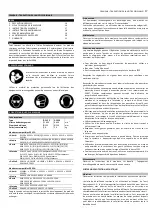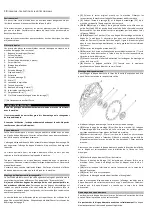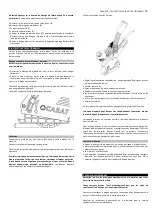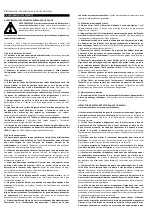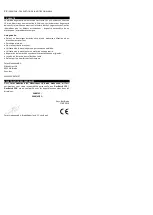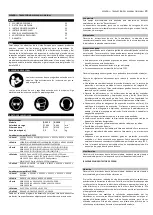
ENGLISCH – ORIGINAL INSTRUCTIONS |
15
5. SERVICE & MAINTENANCE
Pull the mains plug of the power tool from the socket, before any work on
the machine itself.
For safe and proper working, always keep the machine and ventilation slots
clean.
Dismount and clean the diamond grinding wheel, spacer and flanges after
finishing. Clean the guard and extraction hood.
Observe the operating instructions of the grinder for supplementary service
and maintenance activities.
6. SAFETY WARNINGS
GENERAL POWER TOOL SAFETY WARNINGS
WARNING: Read all safety warnings and all instructions.
Failure to follow the warnings and instructions may result in
electric shock, fire and/or serious injury.
Save all warnings and instructions for future reference.
The term “power tool” in the warnings refers to your mains-operated (corded)
power tool or battery-operated (cordless) power tool.
1) Work area safety
a)
Keep work area clean and well lit.
Cluttered or dark areas invite accidents.
b)
Do not operate power tools in explosive atmospheres, such as in the
presence of flammable liquids, gases or dust.
Power tools create sparks
which may ignite the dust or fumes.
c)
Keep children and bystanders away while operating a power tool.
Distractions can cause you to lose control.
2) Electrical safety
a)
Power tool plugs must match the outlet. Never modify the plug in any
way. Do not use any adapter plugs with earthed(grounded) power tools.
Unmodified plugs and matching outlets will reduce risk of electric shock.
b)
Avoid body contact with earthed or grounded surfaces, such as pipes,
radiators, ranges and refrigerators.
There is an increased risk of electric shock
if your body is earthed or grounded.
c)
Do not expose power tools to rain or wet conditions.
Water entering a
power tool will increase the risk of electric shock.
d)
Do not abuse the cord. Never use the cord for carrying, pulling or
unplugging the power tool. Keep cord away from heat, oil, sharp edges and
moving parts.
Damaged or entangled cords increase the risk of electric shock.
e)
When operating a power tool outdoors, use an extension cord suitable
for outdoor use.
Use of a cord suitable for outdoor use reduces the risk of
electric shock.
f)
If operating a power tool in a damp location is unavoidable, use a residual
current device (RCD) protected supply.
Use of an RCD reduces the risk of
electric shock.
3) Personal safety
a)
Stay alert, watch what you are doing and use common sense when
operating a power tool. Do not use a power tool while you are tired or
under the influence of drugs, alcohol or medication.
A moment of
inattention while operating power tools may result in serious personal injury.
b)
Use personal protective equipment. Always wear eye protection.
Protective equipment such as dust mask, non-skid safety shoes, hard hat, or
hearing protection used for appropriate conditions will reduce personal
injuries.
c)
Prevent unintentional starting. Ensure the switch is in the off-position
before connecting to power source and/or battery pack, picking up or
carrying the tool.
Carrying power tools with your finger on the switch or
energizing power tools that have the switch on invites accidents.
d)
Remove any adjusting key or wrench before turning the power tool on.
A
wrench or a key left attached to a rotating part of the power tool may result in
personal injury.
e)
Do not overreach. Keep proper footing and balance at all times.
This
enables better control of the power tool in unexpected situations.
f)
Dress properly. Do not wear loose clothing or jewellery. Keep your hair,
clothing and gloves away from moving parts.
Loose clothes, jewellery or long
hair can be caught in moving parts.
g)
If devices are provided for the connection of dust extraction and
collection facilities, ensure these are connected and properly used.
Use of
dust collection can reduce dust-related hazards.
4) Power tool use and care
a)
Do not force the power tool. Use the correct power tool for your
application.
The correct power tool will do the job better and safer at the rate
for which it was designed.
b)
Do not use the power tool if the switch does not turn it on and off.
Any
power tool that cannot be controlled with the switch is dangerous and must
be repaired.
c)
Disconnect the plug from the power source and/or the battery pack from
the power tool before making any adjustments, changing accessories, or
storing power tools.
Such preventive safety measures reduce the risk of
starting the power tool accidentally.
d)
Store idle power tools out of the reach of children and do not allow
persons unfamiliar with the power tool or these instructions to operate the
power tool.
Power tools are dangerous in the hands of untrained users.
e)
Maintain power tools. Check for misalignment or binding of moving parts,
breakage of parts and any other condition that may affect the power tool’s
operation. If damaged, have the power tool repaired before use.
Many
accidents are caused by poorly maintained power tools.
f)
Keep cutting tools sharp and clean.
Properly maintained cutting tools with
sharp cutting edges are less likely to bind and are easier to control.
g)
Use the power tool, accessories and tool bits etc. in accordance with
these instructions, taking into account the working conditions and the work
to be performed.
Use of the power tool for operations different from those
intended could result in a hazardous situation.
5) Service
a)
Have your power tool serviced by a qualified repair person using only
identical replacement parts.
This will ensure that the safety of the power tool
is maintained.
MACHINE SPECIFIC SAFETY WARNINGS
Safety warnings for wall chasers
Read all safety warnings, instructions, illustrations and specifications
provided with this power tool.
Failure to follow all instructions listed below
may result in electric shock, fire and/or serious injury.
a)
Always use guard provided with the tool. The guard must be securely
attached to the power tool and positioned for maximum safety, so the least
amount of wheel is exposed towards the operator. Position yourself and
bystanders away from the plane of the rotating wheel.
The guard helps to
protect operator from broken wheel fragments and accidental contact with
wheel.
b)
Use only diamond cut-off wheels for your power tool.
Just because an
accessory can be attached to your power tool, it does not assure safe
operation.
c)
The rated speed of the accessory must be at least equal to the maximum
speed marked on the power tool.
Accessories running faster than their rated
speed can break and fly apart.
d)
Wheels must be used only for recommended applications. For example:
do not grind with the side of cut-off wheel.
Abrasive cutoff wheels are
intended for peripheral grinding, side forces applied to these wheels may
cause them to shatter.
e)
Always use undamaged wheel flanges that are of correct diameter for
your selected wheel.
Proper wheel flanges support the wheel thus reducing
the possibility of wheel breakage.
f)
The outside diameter and the thickness of your accessory must be within
the capacity rating of your power tool.
Incorrectly sized accessories cannot be
adequately guarded or controlled.
g)
The arbour size of wheels and flanges must properly fit the spindle of the
power tool.
Wheels and flanges with arbour holes that do not match the
mounting hardware of the power tool will run out of balance, vibrate
excessively and may cause loss of control.
h)
Do not use damaged wheels. Before each use, inspect the wheels for
chips and cracks. If power tool or wheel is dropped, inspect for damage or
install an undamaged wheel. After inspecting and installing the wheel,
position yourself and bystanders away from the plane of the rotating wheel
and run the power tool at maximum no load speed for one minute.
Damaged wheels will normally break apart during this test time.
i)
Wear personal protective equipment. Depending on application, use face
shield, safety goggles or safety glasses. As appropriate, wear dust mask,
hearing protectors, gloves and workshop apron capable of stopping small
abrasive or workpiece fragments.
The eye protection must be capable of
stopping flying debris generated by various operations. The dust mask or
respirator must be capable of filtrating particles generated by your operation.
Prolonged exposure to high intensity noise may cause hearing loss.

















